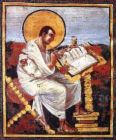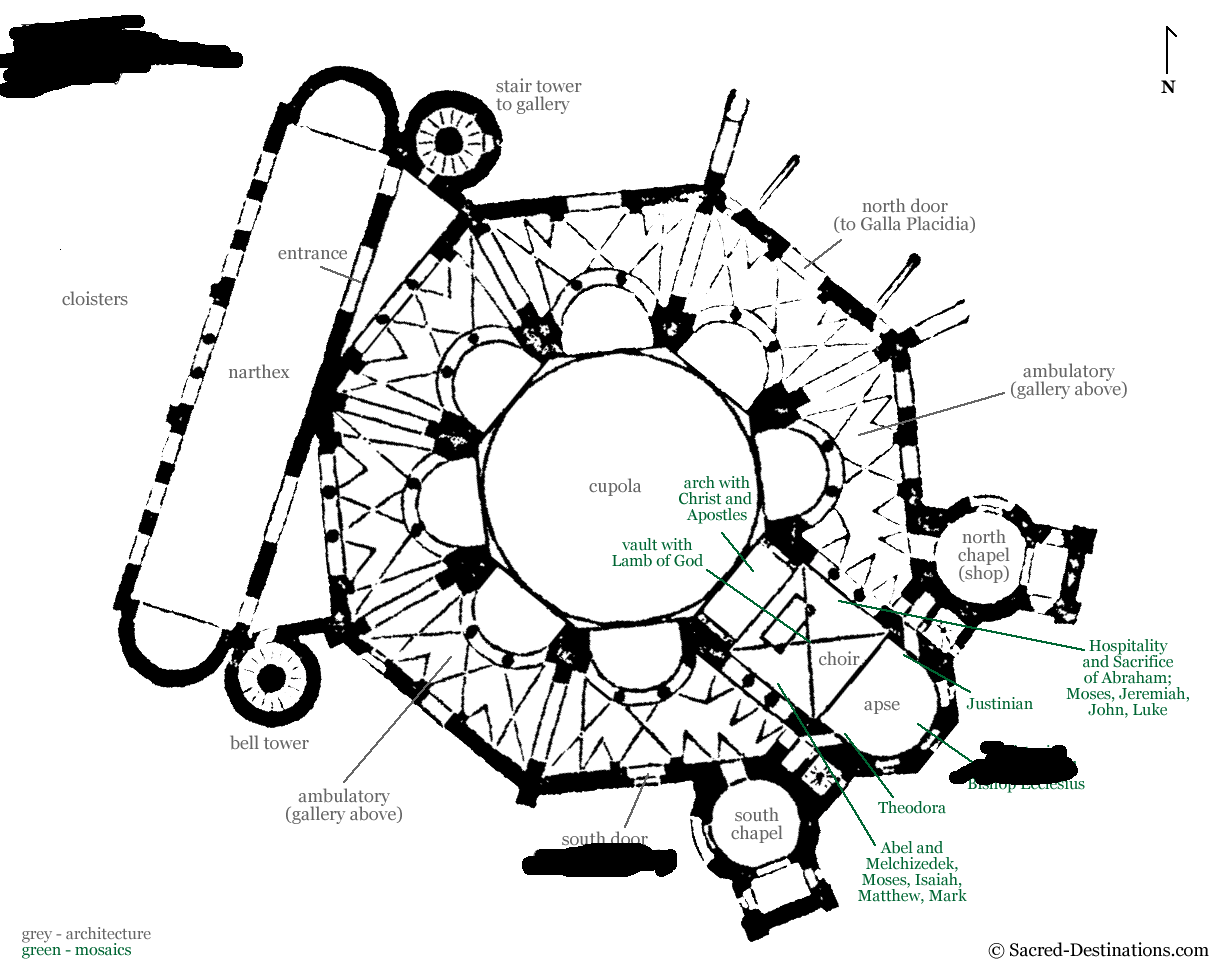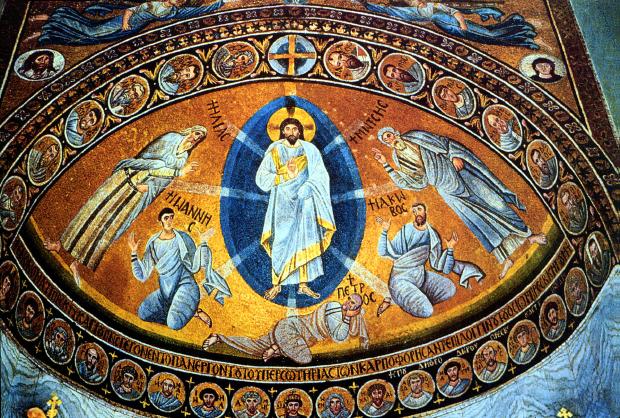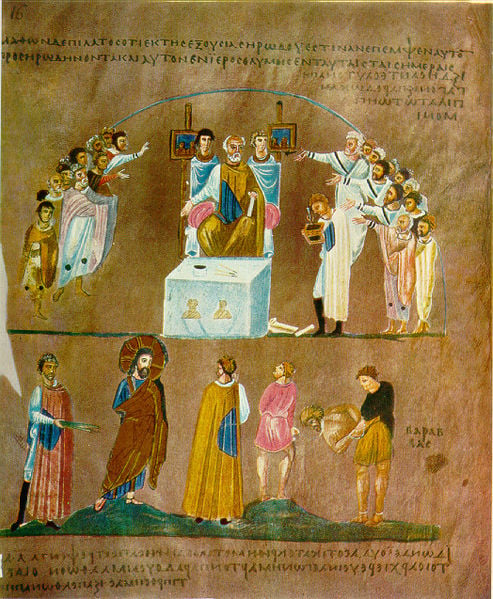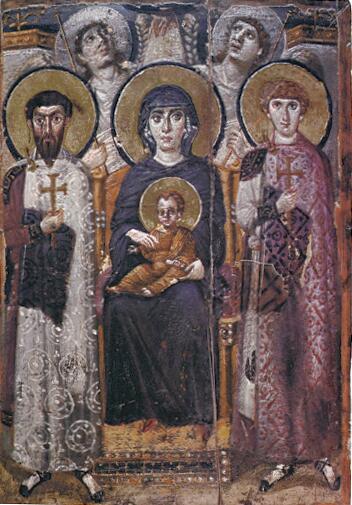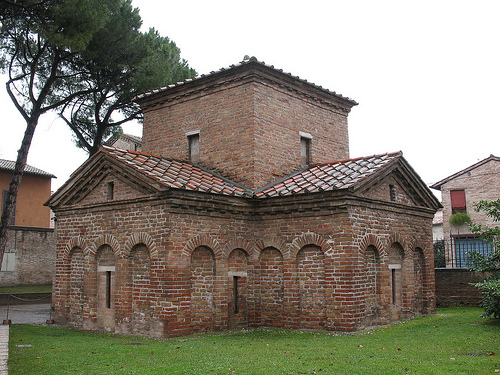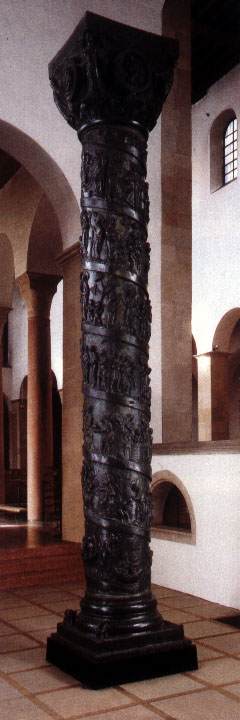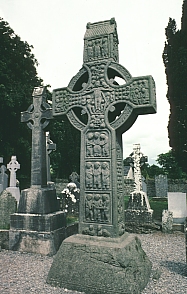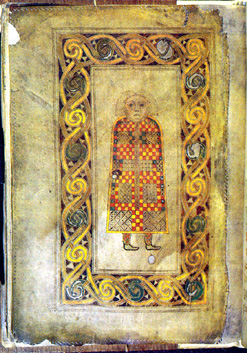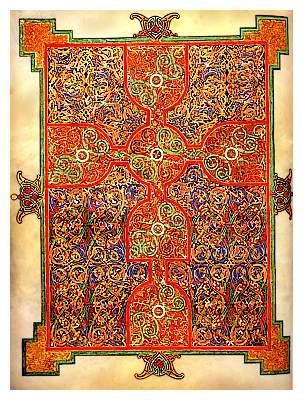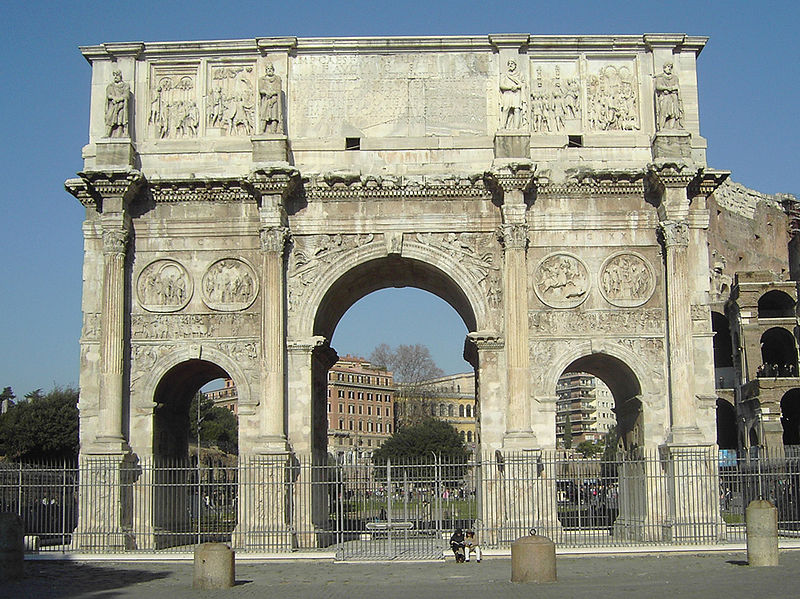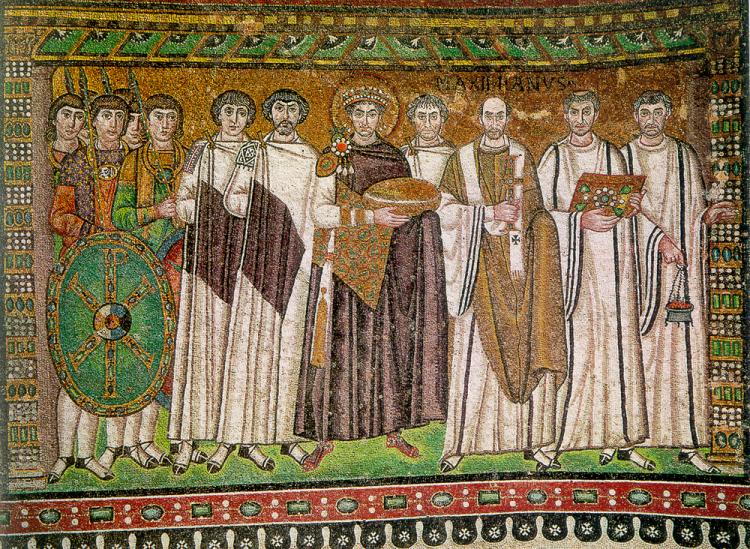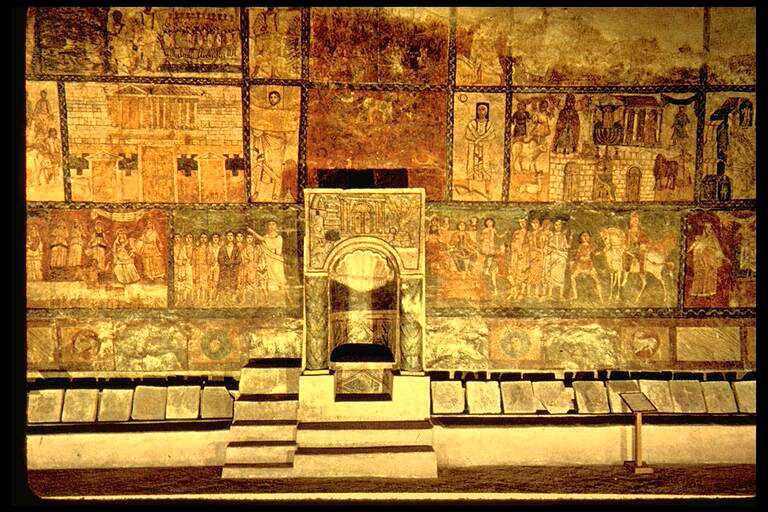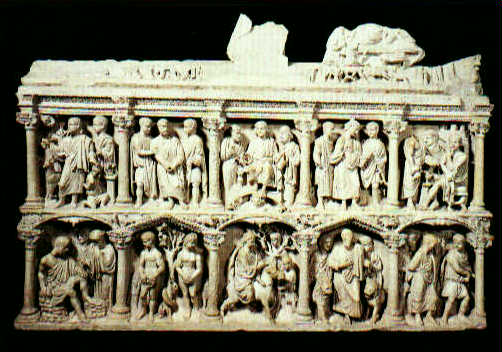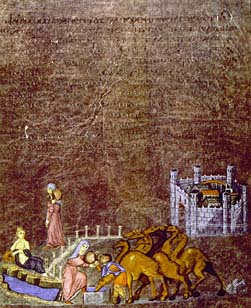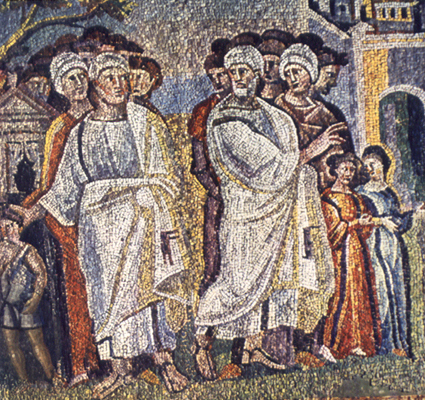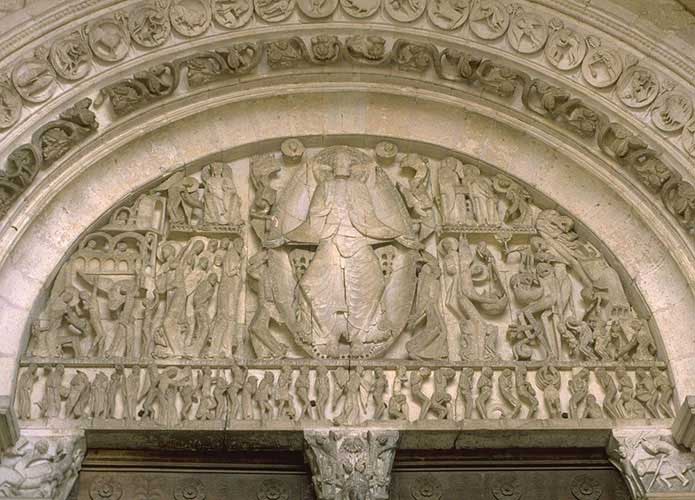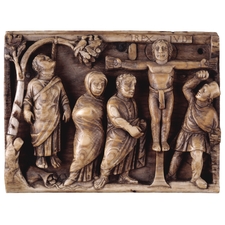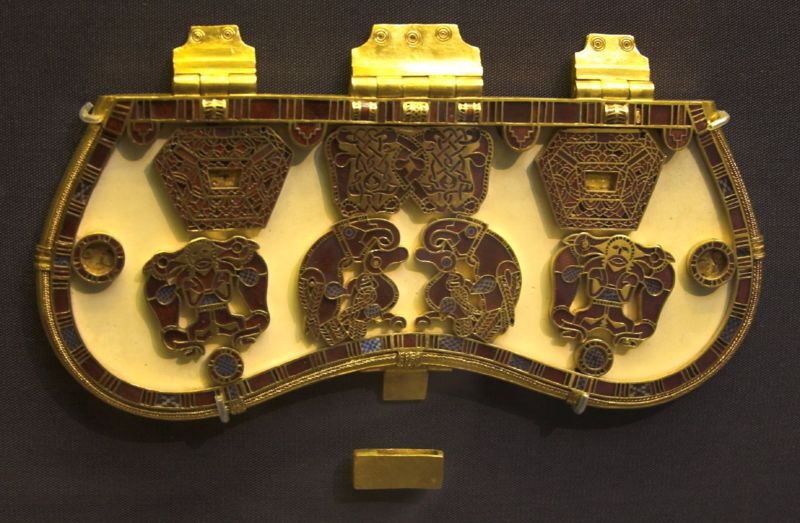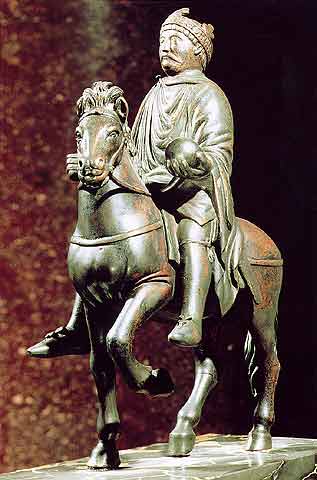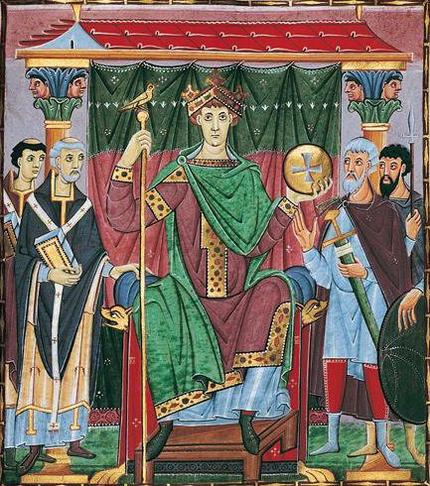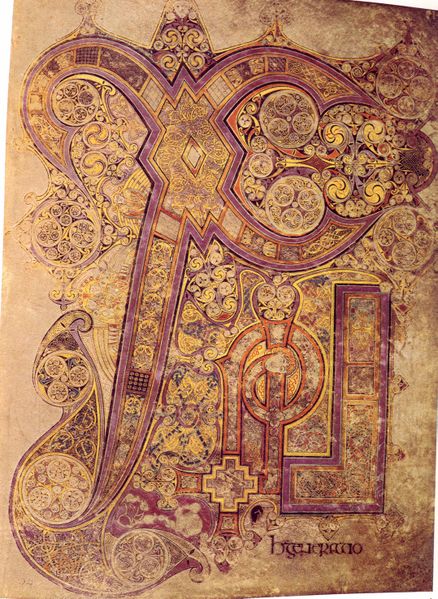The History Of Western Art Practice Test

.
- 1.
A halo (aureole) appearing around the head of a holy figure
- A.
Mandorla
- B.
Abbey
- C.
Nimbus
- D.
Regalia
Correct Answer
C. NimbusExplanation
A nimbus is a halo or a halo-like aura that appears around the head of a holy figure. It is often depicted in religious art to symbolize divinity or holiness. The nimbus is a visual representation of the spiritual radiance or aura surrounding the person, emphasizing their sacred nature. It is commonly seen in depictions of saints, angels, and other revered figures in various religious traditions.Rate this question:
-
- 2.
A painted or sculpted representation of the Virgin Mary mourning over the body of Christ.
- A.
Prefiguration
- B.
Loculi
- C.
Cloister
- D.
Pieta
Correct Answer
D. PietaExplanation
A pieta is a painted or sculpted representation of the Virgin Mary mourning over the body of Christ. It is a powerful and emotional depiction of the sorrow and grief experienced by Mary after the crucifixion of Jesus. The word "pieta" comes from the Italian word for "pity" or "compassion," reflecting the intense empathy and compassion portrayed in these artworks.Rate this question:
-
- 3.
Orant
- A.
A large bowl used for holding the Eucharist bread
- B.
A container used for keeping, holding or displaying a relic
- C.
A porch with a roof supported by columns
- D.
A figure represented with hands raised in prayer position.
Correct Answer
D. A figure represented with hands raised in prayer position.Explanation
The correct answer is "A figure represented with hands raised in prayer position." This is because the term "orant" refers to a specific pose or gesture commonly seen in religious art, where the person is depicted with their hands raised in a prayerful manner. This pose is often associated with worship, supplication, and spiritual devotion. The other options provided in the question are not related to the term "orant" and do not accurately describe its meaning.Rate this question:
-
- 4.
The invisible line in a work of art on which all the most spiritual or mystical elements are arranged or lined up.
- A.
Martyrium
- B.
Theotokos
- C.
Colophon
- D.
Anagogical axis
Correct Answer
D. Anagogical axisExplanation
An anagogical axis refers to the invisible line in a work of art where all the most spiritual or mystical elements are arranged or lined up. This axis represents a deeper meaning or symbolism in the artwork, often associated with religious or metaphysical concepts. It serves to guide the viewer's understanding and interpretation of the piece, leading them towards a higher or transcendental understanding. The term "anagogical" itself means pertaining to spiritual or mystical interpretations, further emphasizing the significance of this axis in conveying a deeper message or connection to the divine.Rate this question:
-
- 5.
An inscription usually on the last page of a book giving information about a books history.
- A.
Mandorla
- B.
Colophon
- C.
Loculi
- D.
Nave
Correct Answer
B. ColophonExplanation
A colophon is an inscription usually found on the last page of a book that provides information about the book's history. It may include details such as the title, author, publisher, date of publication, and any other relevant information. The colophon serves as a way to give readers a deeper understanding of the book's background and production process.Rate this question:
-
- 6.
Baldacchino
- A.
The court of a Roman house that is partly open to the sky.
- B.
A covered walk way.
- C.
A canopy, often freestanding, on columns, frequently built over an altar.
- D.
A new Starbucks drink.
Correct Answer
C. A canopy, often freestanding, on columns, frequently built over an altar.Explanation
The correct answer is a canopy, often freestanding, on columns, frequently built over an altar. A baldacchino is a type of architectural structure that is typically found in churches or religious spaces. It consists of a canopy supported by columns, often built over an altar. It is used to create a sense of grandeur and importance, and to mark the sacred space. The term "baldacchino" is derived from the Italian word "baldachin," which means a rich cloth of gold or silk. The structure is often ornately decorated and serves as a focal point in the space.Rate this question:
-
- 7.
Vellum
- A.
Calfskin prepared as a surface for writing or painting.
- B.
The side post of a doorway.
- C.
Lambskin prepared a surface for painting or writing.
- D.
A person obliged to show loyalty and homage to a feudal lord.
Correct Answer
A. Calfskin prepared as a surface for writing or painting.Explanation
The correct answer is calfskin prepared as a surface for writing or painting. Vellum refers to a type of calfskin that has been specially treated and prepared to be used as a surface for writing or painting. It is a smooth and durable material that was commonly used in medieval times for creating manuscripts and artworks. Vellum is known for its high quality and ability to hold ink or paint well, making it ideal for detailed and intricate work.Rate this question:
-
- 8.
A small building intended to mark the site of a burial of a Christian martyr.
- A.
Mausoleum
- B.
Tympanum
- C.
Martyrium
- D.
Radiating chapel
Correct Answer
C. MartyriumExplanation
A martyrium is a small building that is specifically constructed to commemorate the burial site of a Christian martyr. It serves as a tribute to the martyr and is often considered a sacred place. The term "martyrium" is derived from the Greek word "martyrion," which means witness. The design and architecture of a martyrium can vary, but its primary purpose is to honor and remember the sacrifice of the martyr.Rate this question:
-
- 9.
The lowest stone of an arch
- A.
Jamb
- B.
Spring point
- C.
Trumeau
- D.
Compound piers
Correct Answer
B. Spring pointExplanation
The spring point is the correct answer because it refers to the lowest stone of an arch. This is the point where the arch begins to curve upwards and support the weight above it. The spring point is crucial in distributing the load and maintaining the stability of the arch structure. It marks the transition from the vertical supports (jamb) to the curved arch shape. The trumeau and compound piers are not directly related to the lowest stone of an arch, making them incorrect options.Rate this question:
-
- 10.
A monastery courtyard usually with covered walkways or ambulatories along the sides.
- A.
Baptistery
- B.
Putto
- C.
Jamb
- D.
Cloister
Correct Answer
D. CloisterExplanation
A cloister is a monastery courtyard that typically has covered walkways or ambulatories along the sides. It is a peaceful and enclosed space where monks can meditate, study, and engage in other spiritual activities. The covered walkways provide protection from the elements and create a sense of solitude and tranquility. The word "cloister" is derived from the Latin word "claustrum," meaning enclosed or locked up, emphasizing the seclusion and privacy of this space within the monastery.Rate this question:
-
- 11.
Trumeau
- A.
A hairstyle worn by priest.
- B.
The pillar or central in the middle of a doorway that supports lintel
- C.
The vestibule of a church
- D.
A semi-circular area (with the flatside down) in a wall over a door, a niche, or a window.
Correct Answer
B. The pillar or central in the middle of a doorway that supports lintelExplanation
The correct answer is "the pillar or central in the middle of a doorway that supports lintel." A trumeau is a structural element found in architecture, specifically in doorways. It is a vertical pillar or column that is located in the center of the doorway and serves to support the lintel, which is the horizontal beam or stone that rests on top of the pillars. This helps distribute the weight of the lintel and any stonework above it, ensuring the stability and integrity of the doorway structure.Rate this question:
-
- 12.
A small rectangular shelf like openings in the walls of catacombs to receive the dead.
- A.
Loculi
- B.
Atrium
- C.
Parchment
- D.
Cloisonne´
Correct Answer
A. LoculiExplanation
Loculi are small rectangular shelf-like openings in the walls of catacombs that were used to receive the dead. These openings were commonly used for burials in ancient Rome and were stacked on top of each other to maximize space. The bodies would be placed inside the loculi, often wrapped in cloth or placed in a sarcophagus. This method of burial was a practical solution for limited burial space and allowed for multiple burials in a small area.Rate this question:
-
- 13.
A process of enameling that involves the creation of cells or compartments formed by strips of metal fused to the surface. Those compartments are then filled with molten powdered glass or gems.
- A.
Voussoirs
- B.
Cloisonne´
- C.
Regalia
- D.
Prefiguration
Correct Answer
B. Cloisonne´Explanation
Cloisonné is a process of enameling that involves creating compartments or cells on a metal surface using strips of metal. These compartments are then filled with molten powdered glass or gems. This technique results in a decorative design with vibrant colors and a raised appearance. The other options, voussoirs, regalia, and prefiguration, do not relate to the process of enameling or the creation of compartments using metal strips.Rate this question:
-
- 14.
A two paneled painting or altar piece.
- A.
Cubiculum
- B.
Putto
- C.
Codex
- D.
Diptych
Correct Answer
D. DiptychExplanation
A diptych is a two-paneled painting or altar piece. It consists of two hinged panels that can be closed like a book or opened to display the artwork. This term is commonly used in the context of religious art, where diptychs were often used as altarpieces or devotional objects. The word "diptych" is derived from the Greek word "diptychos," meaning "folded in two."Rate this question:
-
- 15.
Confraternities
- A.
A writing house.
- B.
Organizations founded by lay people who dedicated themselves to strict religious observances.
- C.
A coffin or container for the body, usually made of stone
- D.
The space over a doorway enclosed by a lintel and an arch.
Correct Answer
B. Organizations founded by lay people who dedicated themselves to strict religious observances.Explanation
The correct answer is "organizations founded by lay people who dedicated themselves to strict religious observances." This is because confraternities are typically religious organizations formed by individuals who are not clergy members. These lay people come together to practice and uphold strict religious observances, often focusing on specific devotions or acts of piety. They may engage in communal prayer, charitable works, and other religious activities as a means of deepening their faith and serving their communities.Rate this question:
-
- 16.
A wedge shape block used in the construction a true arch.
- A.
Voussoirs
- B.
Tympanum
- C.
Crossing
- D.
Jamb
Correct Answer
A. VoussoirsExplanation
Voussoirs are wedge-shaped blocks that are used in the construction of a true arch. They are carefully shaped and arranged in a specific order to create the curved shape of the arch. Each voussoir is placed on top of the previous one, with the center being the highest point of the arch. This arrangement allows the weight of the arch to be distributed evenly and creates a stable and strong structure.Rate this question:
-
- 17.
A covered walkway
- A.
Apse
- B.
Narthex
- C.
Tapestry
- D.
Ambulatory
Correct Answer
D. AmbulatoryExplanation
An ambulatory is a covered walkway or passage that allows people to move around a building, typically a church or cathedral. It is often found surrounding the main area of worship and provides a space for people to walk or stand while still being connected to the main space. The other options, apse, narthex, and tapestry, do not specifically refer to a covered walkway and are not as commonly associated with the architectural feature described in the question.Rate this question:
-
- 18.
Pendentives
- A.
An almond shape aureole of light, often encompassing Christ or other holy figures.
- B.
A triangular section of masonry making the structural transition from a square to a circle.
- C.
A monumental tomb.
- D.
Nude, often wing, cherubic young boy.
Correct Answer
B. A triangular section of masonry making the structural transition from a square to a circle.Explanation
The correct answer is a triangular section of masonry making the structural transition from a square to a circle. Pendentives are architectural elements that help support a dome or a circular structure on top of a square or polygonal base. They are triangular in shape and are used to transition the load from the base to the dome. Pendentives are commonly found in Byzantine and Islamic architecture and are considered a key feature in creating domed structures.Rate this question:
-
- 19.
The codification of of Roman law under Emperor Justinian.
- A.
Renovatio Imperii Romani
- B.
Corpus juris civilis
- C.
Hagia Sophia
- D.
Christus Patiens
Correct Answer
B. Corpus juris civilisExplanation
The correct answer is Corpus juris civilis. Corpus juris civilis refers to the codification of Roman law under Emperor Justinian. It is a collection of legal texts that served as the foundation for modern civil law systems. This codification aimed to consolidate and organize the existing Roman laws to ensure consistency and clarity in legal matters. The Corpus juris civilis had a significant impact on the development of legal systems in Europe and beyond.Rate this question:
-
- 20.
What was the date that Charlemagne was crowned Roman Emperor by Pope Leo III?
- A.
Easter Day 801
- B.
Christmas Day 765
- C.
Christmas Day 800
- D.
Easter Day 455
Correct Answer
C. Christmas Day 800Explanation
Charlemagne was crowned Roman Emperor by Pope Leo III on Christmas Day 800. This event marked the revival of the Western Roman Empire and the beginning of the Carolingian Empire. It was a significant moment in European history as it established a strong alliance between the papacy and the Frankish kingdom, and it also symbolized the union of the spiritual and temporal powers.Rate this question:
-
- 21.
What codex is this illumination of St. Matthew from?
- A.
Book of Kells
- B.
Ebbo Gospels
- C.
Coronation Gospels
- D.
Gospel Book of Otto
Correct Answer
C. Coronation GospelsExplanation
This illumination of St. Matthew is from the Coronation Gospels.Rate this question:
-
- 22.
What building is this?
- A.
Masoleum of Galla Placidia
- B.
Santa Sabina
- C.
Santa Costanza
- D.
San Vitale
Correct Answer
D. San VitaleExplanation
San Vitale is the correct answer because the image shows the interior of the San Vitale Basilica in Ravenna, Italy. The distinctive octagonal shape of the building, along with the intricate mosaics and columns, are characteristic features of San Vitale. The other options, such as the Masoleum of Galla Placidia, Santa Sabina, and Santa Costanza, are different buildings with their own unique architectural styles and characteristics.Rate this question:
-
- 23.
Who is commemorated in the carved ivory panel?
- A.
Charlemagne
- B.
Otto III
- C.
Justinian
- D.
Constantine
Correct Answer
C. JustinianExplanation
The correct answer is Justinian because the question asks who is commemorated in the carved ivory panel. Since Justinian is the only option provided, it can be inferred that the carved ivory panel is specifically dedicated to Justinian.Rate this question:
-
- 24.
What is St. Benedict known for?
- A.
Architect for Hagia Sophia
- B.
Writing the standard for Western Monastic Institutions.
- C.
Building the first abbey.
- D.
Creating the first ale.
Correct Answer
B. Writing the standard for Western Monastic Institutions.Explanation
St. Benedict is known for writing the standard for Western Monastic Institutions. This refers to the Rule of Saint Benedict, a guidebook for monastic life that he wrote in the 6th century. The Rule provides instructions on various aspects of monastic life, including prayer, work, and community living. It became widely influential and is still followed by many monastic communities today. St. Benedict's Rule is considered a foundational text in Western monasticism and has had a lasting impact on religious life in the Western Christian tradition.Rate this question:
-
- 25.
What is the date?
- A.
548-565
- B.
512-516
- C.
499-501
- D.
523-530
Correct Answer
A. 548-565 -
- 26.
What codex is this folio from?
- A.
Vienna Genesis
- B.
Sant' Apollinare
- C.
Rossano Gospels
- D.
Rabbula Gospels
Correct Answer
C. Rossano GospelsExplanation
The correct answer is Rossano Gospels. This suggests that the folio in question is from the Rossano Gospels codex.Rate this question:
-
- 27.
What is the medium?
- A.
Tempera on Vellum
- B.
Encaustic on wood
- C.
Apse mosaic
- D.
Painted limestone
Correct Answer
B. Encaustic on woodExplanation
Encaustic on wood refers to a painting technique where pigments are mixed with hot wax and then applied to a wooden surface. This method allows for a rich and vibrant color palette, as well as a textured and layered effect. The use of encaustic on wood was popular in ancient times and has been used by artists throughout history. It is a durable medium that can withstand the test of time, making it a suitable choice for creating long-lasting artworks.Rate this question:
-
- 28.
What is the date of Mausoleum of Galla Placidia?
- A.
324
- B.
500
- C.
425
- D.
800
Correct Answer
C. 425Explanation
The Mausoleum of Galla Placidia is a famous building located in Ravenna, Italy. It was built around 425 AD and is known for its beautiful mosaics and architectural style. This date aligns with the time period of the late Roman Empire and the reign of Galla Placidia, who was a prominent figure in the Western Roman Empire during that era.Rate this question:
-
- 29.
Where is this located?
- A.
Hildesheim, Germany
- B.
Toulouse, France
- C.
Modena, Italy
- D.
Moissac, France
Correct Answer
A. Hildesheim, GermanyExplanation
This location is located in Hildesheim, Germany.Rate this question:
-
- 30.
When is the High Cross of Muiredach dated?
- A.
655
- B.
983
- C.
923
- D.
455
Correct Answer
C. 923Explanation
The High Cross of Muiredach is dated to 923.Rate this question:
-
- 31.
What codex is this folio from?
- A.
Book of Kells
- B.
Book of Durrow
- C.
Lindisfarne Gospels
- D.
Coronation Gospels
Correct Answer
B. Book of DurrowExplanation
The correct answer is Book of Durrow. This is because the question asks for the codex that the folio is from, and the Book of Durrow is one of the options provided. The other options, such as the Book of Kells, Lindisfarne Gospels, and Coronation Gospels, are not the correct answer in this case. Therefore, the folio in question is from the Book of Durrow.Rate this question:
-
- 32.
What is the Date?
- A.
698-721
- B.
660-680
- C.
1050-1070
- D.
923
Correct Answer
A. 698-721 -
- 33.
What does the Bayeux Tapestry Commemorate?
- A.
Christus Patiens
- B.
The Transfiguration
- C.
The Ascension
- D.
The Battle of Hastings
Correct Answer
D. The Battle of HastingsExplanation
The Bayeux Tapestry is a historical artifact that depicts the events leading up to and including the Battle of Hastings in 1066. It is believed to have been commissioned by Bishop Odo, William the Conqueror's half-brother, and serves as a visual record of the Norman conquest of England. The tapestry portrays the events in a narrative format, showcasing the battle scenes, key figures, and important moments of the conflict. Therefore, the correct answer is "The Battle of Hastings."Rate this question:
-
- 34.
Who were the architects of the Hagia Sopihia?
- A.
Justinian and Theodora
- B.
Anthemius and Isidorus
- C.
Dura and Europas
- D.
Bernardus Gelduinus
Correct Answer
B. Anthemius and IsidorusExplanation
Anthemius and Isidorus were the architects of the Hagia Sophia. They were commissioned by Emperor Justinian I to design and construct the grand cathedral in Constantinople (now Istanbul) in the 6th century. The Hagia Sophia is renowned for its innovative architectural features, including its massive dome, intricate mosaics, and impressive size. Anthemius and Isidorus successfully created a masterpiece that combined elements of Roman, Byzantine, and Eastern architecture, leaving a lasting impact on architectural history.Rate this question:
-
- 35.
What is this dated?
- A.
312-315
- B.
300-310
- C.
345-360
- D.
209-223
Correct Answer
A. 312-315Explanation
The given answer, 312-315, represents a specific range of dates. It is likely that the question is asking for the date within this range.Rate this question:
-
- 36.
What is the Period?
- A.
Byzantine
- B.
Romanesque
- C.
Late Antiquity
- D.
Early Medieval
Correct Answer
A. ByzantineExplanation
The period referred to in this question is asking about a specific historical time period. The correct answer, Byzantine, indicates that the period being referred to is the Byzantine period. This period is known for its distinct art, architecture, and culture that developed in the Eastern Roman Empire after the fall of the Western Roman Empire. It is characterized by its unique blend of Roman, Greek, and Eastern influences, and it lasted from the 4th century to the 15th century.Rate this question:
-
- 37.
Where is this located?
- A.
Mount Sinai
- B.
Dura-Europos
- C.
Constantinople
- D.
New York City
Correct Answer
B. Dura-EuroposExplanation
Dura-Europos is the correct answer because it was an ancient city located in modern-day Syria. It was situated on the banks of the Euphrates River and was an important cultural and military center during the Hellenistic, Parthian, and Roman periods. The city was known for its diverse population and the presence of various religious and cultural groups. Archaeological excavations at Dura-Europos have provided valuable insights into the ancient world and have uncovered well-preserved structures such as temples, houses, and a synagogue.Rate this question:
-
- 38.
Who's Sarcophagus?
- A.
Justinian
- B.
Otto III
- C.
Junius Bassus
- D.
Theodora
Correct Answer
C. Junius BassusExplanation
Junius Bassus is the correct answer because he was a prominent figure in ancient Rome who died in 359 AD. He was a member of the Roman aristocracy and held various high-ranking positions in the government. After his death, a grand sarcophagus was created to house his remains, which is considered one of the finest examples of early Christian art. The sarcophagus depicts scenes from both the Old and New Testaments, showcasing the influence of Christianity in the late Roman Empire.Rate this question:
-
- 39.
What is codex is this folio from?
- A.
Rossano Gospels
- B.
Vienna Genesis
- C.
Ebbo Gospels
- D.
Book of Durrow
Correct Answer
B. Vienna GenesisExplanation
The correct answer is Vienna Genesis. The Vienna Genesis is a 6th-century illuminated manuscript, believed to be the oldest surviving illustrated biblical codex. It contains the Book of Genesis and is written in Greek. The manuscript is famous for its vibrant and detailed illustrations, which depict scenes from the biblical story of Genesis. The Vienna Genesis is considered a masterpiece of early Christian art and is housed in the Austrian National Library in Vienna.Rate this question:
-
- 40.
Where is this located?
- A.
Sant Apollinare
- B.
Santa Maria Maggiore
- C.
San Vitale
- D.
Palatine Chapel of Charlemagne
Correct Answer
B. Santa Maria MaggioreExplanation
Santa Maria Maggiore is located in Rome, Italy. It is one of the four major basilicas in the city and is dedicated to the Virgin Mary. The basilica is known for its stunning architecture and beautiful interior, including intricate mosaics and a ornate ceiling. It is a popular tourist attraction and a significant religious site for Catholics.Rate this question:
-
- 41.
Who is the artist?
- A.
Gislebertus
- B.
Bernardus Gelduinus
- C.
Wiligelmo
- D.
St. Benedict
Correct Answer
A. GislebertusExplanation
The artist referred to in the question is Gislebertus. This can be inferred from the fact that Gislebertus is the first option listed and is followed by three other names. The question asks for the artist's name, and since Gislebertus is the first option, it is the correct answer.Rate this question:
-
- 42.
What is the date?
- A.
1100
- B.
1015
- C.
985
- D.
998-1005
Correct Answer
B. 1015 -
- 43.
What is the size of this plaque?
- A.
3 inches x 3 7/8 inches
- B.
6 inches x 10 inches
- C.
4 ft x 2 ft
- D.
8 cm x 4 cm
Correct Answer
A. 3 inches x 3 7/8 inchesExplanation
The size of the plaque is 3 inches x 3 7/8 inches. This is determined by the dimensions provided in the answer option.Rate this question:
-
- 44.
What is the date?
- A.
803 AD
- B.
625 AD
- C.
400 AD
- D.
1000 AD
Correct Answer
B. 625 AD -
- 45.
Who is commemorated?
- A.
Charlemagne
- B.
Justinian
- C.
Otto III
- D.
Saint Matthew
Correct Answer
A. CharlemagneExplanation
Charlemagne is commemorated. Charlemagne, also known as Charles the Great, was the King of the Franks and Lombards and later became the Holy Roman Emperor. He is widely regarded as one of the most important and influential figures in European history. Charlemagne's reign was marked by significant military conquests, political reforms, and cultural revival, earning him the title "Father of Europe." His commemoration is a recognition of his immense impact on the development of medieval Europe and his role in shaping the continent's history.Rate this question:
-
- 46.
Where is the Palatine Chapel of Charlemagne located?
- A.
France
- B.
Italy
- C.
Germany
- D.
Syria
Correct Answer
C. GermanyExplanation
The Palatine Chapel of Charlemagne is located in Germany. This chapel, also known as Aachen Cathedral, was built by Charlemagne in the 8th century and is located in Aachen, a city in western Germany. It is considered a masterpiece of Carolingian architecture and has significant historical and cultural importance.Rate this question:
-
- 47.
When is this folio dated?
- A.
645-650
- B.
997-1000
- C.
655-670
- D.
890-895
Correct Answer
B. 997-1000Explanation
The folio is dated 997-1000 because it falls within the given range of dates.Rate this question:
-
- 48.
What is the symbol for the Evangelist's Matthew & Luke?
- A.
Winged lion and Fish
- B.
Winged Ox and Winged Lion
- C.
Winged Man & Winged OX
- D.
Eagle and Winged Man
Correct Answer
C. Winged Man & Winged OXExplanation
The symbol for the Evangelist's Matthew and Luke is the Winged Man and Winged Ox. This symbol represents the four Evangelists in Christian tradition, with each Evangelist being associated with a different symbol. The Winged Man represents Matthew, who is often depicted as an angelic figure or a human figure with wings. The Winged Ox represents Luke, symbolizing sacrifice and service. These symbols are commonly used to represent the Gospels of Matthew and Luke in Christian art and iconography.Rate this question:
-
- 49.
What codex is this folio from?
- A.
Book of Kells
- B.
Book of Durrow
- C.
Lindisfarne Gospels
- D.
Coronation Gospels
Correct Answer
A. Book of KellsExplanation
This folio is from the Book of Kells because it is one of the most famous illuminated manuscripts in the world, known for its intricate and colorful illustrations. The Book of Kells was created around the 9th century in Ireland and is highly regarded for its artistic and historical significance.Rate this question:
-
Quiz Review Timeline +
Our quizzes are rigorously reviewed, monitored and continuously updated by our expert board to maintain accuracy, relevance, and timeliness.
-
Current Version
-
Nov 16, 2023Quiz Edited by
ProProfs Editorial Team -
Dec 06, 2008Quiz Created by
Jc_ucf2008
 Back to top
Back to top



